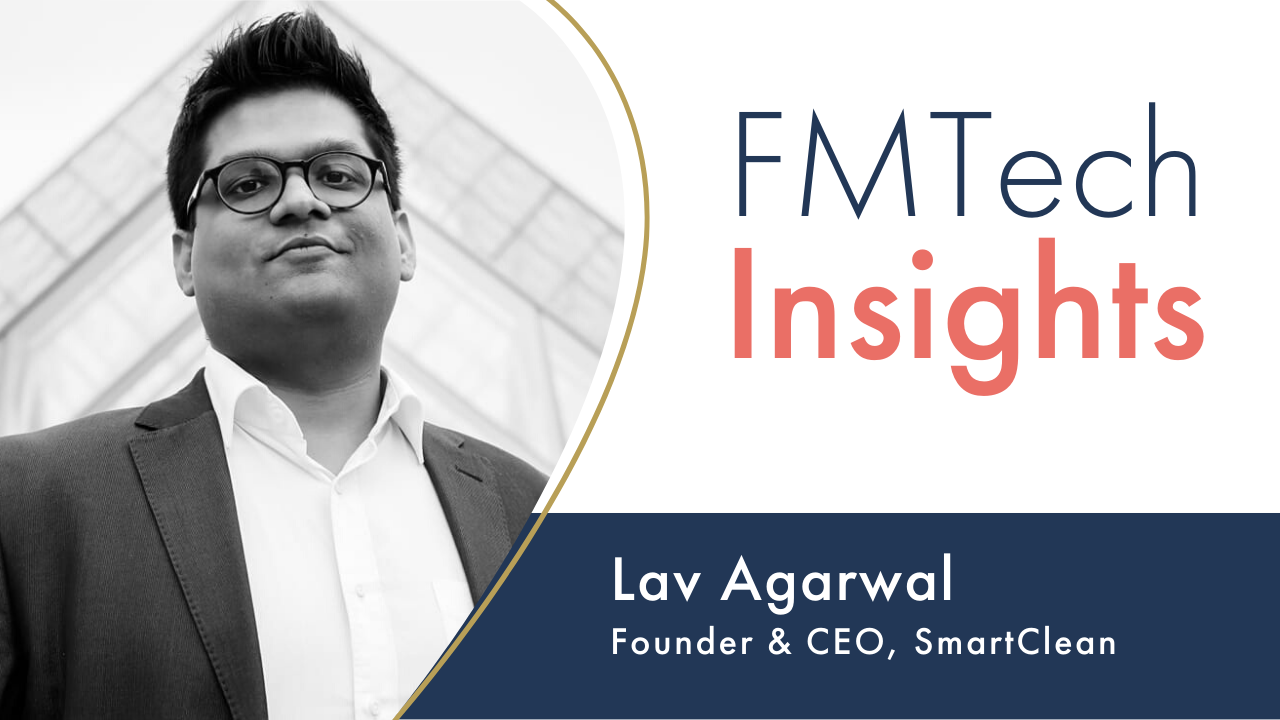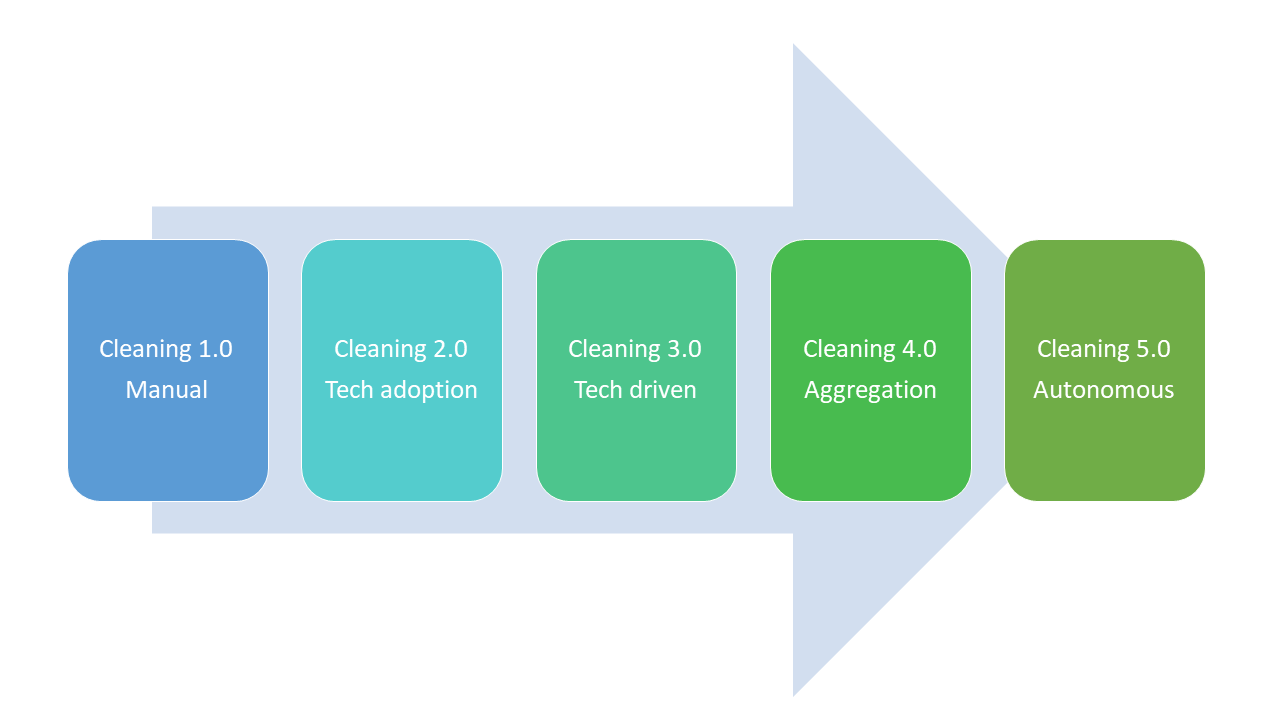FMTech Insights: The Future Cleaning Company is a Tech company!

FMTech Insights is a series where subject matter experts and thought leaders in FMTech share their knowledge and opinions on the topic of their expertise; helping the industry learn, innovate and grow. The series will cover every sector in FM – from workplace management, operations and maintenance, energy management, waste management and everything in between.
Lav Agarwal is the Founder & CEO at SmartClean, a Cleanliness and Hygiene Intelligence company and has built IoT & SaaS powered Digital Cleaning solutions to fundamentally change how Cleanliness & Hygiene are monitored, measured and managed in the built environment towards improved health and hygiene standards.
FMTech Insights: The Future Cleaning Company is a Tech company!

It's really not possible to track how old the Cleaning Industry is! People and businesses have hired people to clean for them for probably thousands of years. And ever since Commercial cleaning became a thing, Cleaning has primarily been a manpower business, after all over 80-90% of the Cleaning costs are attributed to manpower costs. Cleaning forms one of the larger segments of Facility Management (FM) today, alongside Security services, and contributes to almost 20% of the FM contracts.
The evolution of the Cleaning Industry:
Cleaning Industry today is a US$300 Bil+ industry undergoing a paradigm shift, transforming from a manpower business to technology business.
Cleaning 1.0 to 2.0: For a long time, the Cleaning Industry stayed almost all manual, with the usage of tools and equipment. The digital transformation of the industry started a few decades back with the adoption of silo software for workforce management etc. and cleaning machines. The commercial cleaning contracts were headcount-based contracts, where the Property/FM would list exactly the number of Cleaners to be deployed and the frequency of Cleaning that was expected to be performed. Both sides, service buyers and providers, were completely dependent on the Cleaners on the ground with limited to no visibility. The only way a Property/FM manager could assess the quality of Cleaning, was by manual inspections on the ground.
This approach was incredibly inefficient, as it needed the Facility Management teams to go through excruciating details as to how, when, and where every task must occur.
The industry shift to Outcome-based contracts: The last decade saw the Industry transition from a Headcount-based/Input model to an Outcome-based model, whereby the Facility Management teams will simply explain their expectations for the final outcome and leave the details on the professional judgment of the Cleaning vendor. The Facility Management team can periodically check the progress and that the outcomes are met.
It appeared to be a good solution, but the problem with Cleaning is that it's very subjective and there are no quantifiable ways of measuring what's Clean. Not to mention, this still needs Facility Management teams to go around and visually inspect the Facility and rate Cleanliness using scorecards to evaluate if the SLAs are met.
On top of this, today's buildings are very dynamic with changing usage patterns where no two days are similar, and it's physically not possible for Cleaning managers to estimate the daily Cleaning requirements.
The rise of Smart Buildings: The technical advancements in IoT, AI and software have completely changed how we build, occupy and operate Commercial Real Estate (CRE). The adoption of Smart Buildings solutions has seen the digitization of almost every FM vertical. Both hard and soft services, including HVAC, MEP, Security, Space and asset management and even Experience & wellbeing are seeing a technological transformation for data-driven services. This has led to on-demand service models, with real-time visibility into operations, predictive maintenance, improved service quality, and increased productivity.
However, Cleanliness and Hygiene management has seen the least digitization from Smart building positioning with limited focus on Air Quality monitoring, and even global certifications like IWBI - WELLs doesn't consider Cleanliness levels in the ratings. The primary reason for this and lack of standardization is the absence of data. Cleanliness and Hygiene have never been quantified before, so it becomes impossible to have any standard scale to measure and rate against.
How Clean is Clean? The built environment today lacks Cleanliness and Hygiene data
Introducing SmartClean - IoT, AI & SaaS powered Data-driven Cleaning
SmartClean's journey started with developing IoT solutions, as we realized the biggest problem in Cleaning Industry was the absence of data. Our solutions such as Smart Toilet/Restroom, gave real-time visibility into Cleanliness levels enabling on-demand Cleaning. And as we commercialized and scaled these solutions globally, we realized more and more that these silo IoT solutions need to merge with mainstream Cleaning operations to create a quantifiable impact and ROI sense on business case. So we built an end-to-end Cleaning OS for Properties and FM companies to digitize and optimize, how Cleaning is procured, managed, monitored and audited.
We are building the brain, nervous system and Operating system of the Future of Cleaning.
- RealSense: Specialized AIOT systems monitoring different aspects of Cleanliness & Hygiene in real-time, with proprietary AI engine computing real-time CleanScore qualifying Cleanliness, for enabling on-demand Cleaning and Healthy Building solutions.
- Cleaning Operating System Matrix: SaaS platform Matrix enabling Properties and Facility Management companies, to use the collected data to digitize the entire lifecycle of Cleaning operations, starting from how they procure Cleaning contracts to how Cleaning performance and standards are measured and audited.
- Supersense: Acting as brain of the Cleaning OS Matrix, Supersense is AI/ML engine learning from millions of collected data points, to monitor and run Cleaning operations. Supersense is being integrated to 3rd party Cleaning robots to control and run a fleet of robots autonomously.
Cleaning 3.0: Over the last year, we have seen the transition from tech-adoption to technology-driven Cleaning contracts. Majority of Commercial Properties today are looking to deploy smart-cleaning regime for data-driven Cleaning operations. The Outcome/ Performance based Cleaning contracts already list how they expect Integrated technology platform to measure, monitor and track performance metrics to compute a performance score. The technology portion in the contract value is going up to 20%. The business case being, by spending 15-20% on the Technology adoption, the overall manpower can be optimized by up to 30%, hence saving upwards of 10% on the entire Cleaning spend.
In our recent engagement with a leading Property group with inhouse FM, they listed in their Cleaning RFQ, that how the Cleaning vendor should optimize their manpower to reduce 10% Cleaners Y-o-Y to reduce overall 30% by Year 3. This also gives a clear undertaking to Cleaning vendors who otherwise may treat technology as a good-to-have add-on, than an essential way of digitizing operations. The ownership of this platform and data, also needs to be with Property/FM, as this data could be used for Contract management, quantifying SLAs, assessing User experience and overall Cleaning performance.
The transition to Cleaning 3.0 is also fundamentally changing the business models at play.
The traditional model was that a Property (with an in-house FM) or a FM company will be outsourcing Cleaning portion to a Commercial Cleaning company. But if an Intelligent platform learning from the building data, was to decide how Cleaning operations should be scheduled, run a man-machine workforce, while measuring the User experience and performance metrics, it standardizes the quality and outcome across a portfolio of buildings. Infact, our engagement with one of the Big 3 IFM companies, revealed this is one of their biggest challenge. They engage 1000s of Cleaning companies globally, and it becomes impossible to commit a Cleaning standard to end-client when there is no data and they are so dependent on the Cleaners on ground.
Cleaning 4.0 The next business model innovation we foresee, is that Properties/FM will be working directly with Technology companies, whose solutions will help them take total control of Cleaning management. This can lead to Technology providers like SmartClean to become aggregators of Cleaning operations, whereby the Intelligent Cleaning system can be procuring Cleaning from a pool of pre-trained/certified freelance cleaners and Cleaning companies. If the gig-economy model were deployed correctly, skilled Cleaners could be making $5000 to $6000 monthly, owing to the supply and demand economics, also solving the manpower problem of the industry.
(In Singapore ecosystem, we saw the rollout of Progressive-wage (PWM) models, which outlines how Cleaners/Supervisor's wages should be incremented over the next decade to match up with other service industries. While Progressive wage model (PWM) is doing it's part for the Cleaning Industry; the PWM alone can't solve the underlying problems and the reliance on the foreign workforce. The current system doesn't reward a highly-efficient more-skilled Cleaner vs a average one and offers very limited growth paths. Moreover today's lower-end workforce has a choice owing to gig-economy models, a choice between e.g. choosing a food-delivery job and making $3,000+ or becoming a Cleaner and making $2,000+, and the choice is obvious. That's why we see mostly older folks joining the Industry who couldn't pickup such gig-jobs.)
As the autonomous Cleaning robotics expands to more and more use cases, the % of technology (vs humans) will keep going up over the next 1-2 decades to become the majority.
Cleaning 5.0 As a human race, we are looking into consciousness transfer and extra-terrestrial expansion, it is not impossible to imagine that in the next few decades (2-3), Cleaning will be completely/near autonomous like many other service industries. And comparing to a close parallel- the transportation industry, once the autonomous taxis are commercialized, aggregators like UBER will eliminate the human loop and become pure Technology operations. In fact, Cleaning Industry is much easier to become autonomous owing to the low impact of tech failure, which can be quickly resolved and has no serious implications.
The future Cleaning company is a Technology company.
Though dynamic, Buildings are much more simpler than complex transportation networks, and autonomous robot deployment in a building has no challenges of an Autonomous vehicle (AV), like harsh road, traffic and weather conditions and the chances of an AV getting lost.
SmartClean has been building a Digital Cleaning twin (Grids) enabled with indoor localization, and mapped with the Cleaning requirements of the Building, to which all the silo cleaning robots can be connected. The issues picked by real-time monitoring via sensors and scheduled cleaning work orders can be allocated to Robots depending on the scenario.
We foresee a long journey ahead, and to be an integral part of this Industry transformation towards Cleaning 5.0!
Disclaimer: the opinion of the author does not necessarily reflect that of the Global Alliance of Facility Management Innovators.

